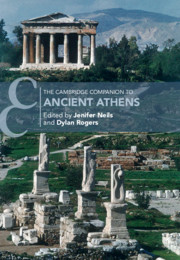Book contents
- The Cambridge Companion to Ancient Athens
- Cambridge Companions to the Ancient World
- The Cambridge Companion to Ancient Athens
- Copyright page
- Contents
- Contributors
- Abbreviations
- Athens: An Introduction
- 1 #Leagros: An Athenian Life
- Part I The Urban Fabric
- Part II Inhabitants
- Part III Business/Commerce
- Part IV Culture and Sport
- Part V Politics
- Reception
- 30 Roman Athens
- 31 Early Travelers and the Rediscovery of Athens
- 32 Modern Athens and Its Relationship with the Past
- 33 Urban Archaeology: Uncovering the Ancient City
- Index
- References
30 - Roman Athens
from Reception
Published online by Cambridge University Press: 10 March 2021
- The Cambridge Companion to Ancient Athens
- Cambridge Companions to the Ancient World
- The Cambridge Companion to Ancient Athens
- Copyright page
- Contents
- Contributors
- Abbreviations
- Athens: An Introduction
- 1 #Leagros: An Athenian Life
- Part I The Urban Fabric
- Part II Inhabitants
- Part III Business/Commerce
- Part IV Culture and Sport
- Part V Politics
- Reception
- 30 Roman Athens
- 31 Early Travelers and the Rediscovery of Athens
- 32 Modern Athens and Its Relationship with the Past
- 33 Urban Archaeology: Uncovering the Ancient City
- Index
- References
Summary
In the shadows of its Classical past, Athens during the Roman period saw a number of changes at the hands of imperial or local individuals, particularly for political and ideological, religious, and cultural and educational motivations. This chapter explores how the city grew and developed under the Romans, creating a unique urban space that expressed a multifaceted identity.
- Type
- Chapter
- Information
- The Cambridge Companion to Ancient Athens , pp. 421 - 436Publisher: Cambridge University PressPrint publication year: 2021
References
Further Reading
Over the course of the last three decades, scholars have begun to pay greater attention to the city of Athens in the Roman period, a time often overlooked in light of the glories of the Classical period. Important edited volumes on a range of topics include Hoff and Rotroff 1997, Ostenfeld 2002, Vlizos 2008, Caliò et al. 2012, Dijkstra et al. 2017, and Di Napoli et al. 2018. See the work of the Roman Seminar in Athens, which hosts an annual international lecture series on topics related to Roman Greece (http://sites.google.com/view/romanseminar), along with the Ancient Athens 3D project for digital reconstructions of monuments of Roman Athens and other time periods of Athenian history (www.ancientathens3d.com). For a succinct discussion of the monuments installed in the city under the Romans, see Raja 2012, 92–135, including issues related to regional identity, along with Rous 2019, especially 198–209, and Yegül and Favro 2019, 579–595. Late Hellenistic Athens is explored in Habicht 1997. On issues related to Athens under the rule of Augustus, see for example Spawforth 2012. The role of Hadrian and Athens can be found in a number of new publications, including Lagogianni-Georgakarakos and Papi 2018. See Tobin 1997 for a discussion of the construction projects of Herodes Atticus. Those interested in learning more about Christian Athens can turn to the work of Baldini (e.g. in Caliò et al. 2012); on Byzantine Athens, see most recently Bouras 2017; and on Ottoman Athens, see Georgopoulou and Thanasakis 2019.
Bibliography
Additional resources to accompany this chapter can be found at: www.cambridge.org/NeilsRogers
- 2
- Cited by

